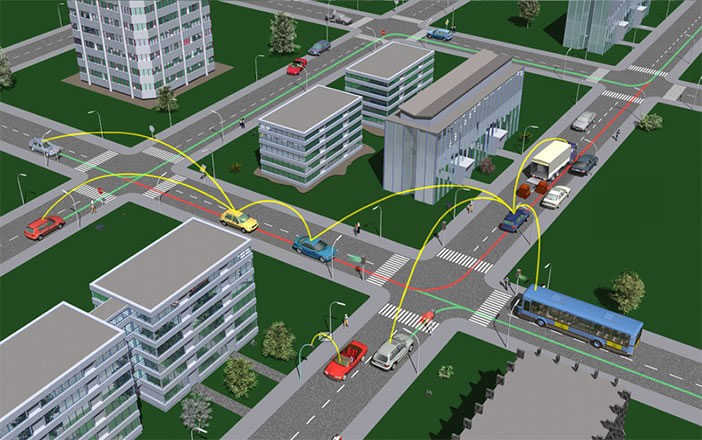V2X is an intelligent transport system comprising of Vehicle-to-vehicle (V2V), Vehicle-to-infrastructure (V2I), and Vehicle-to-Pedestrian (V2P) communications. Biometric seat technology; autonomously managed municipality; and highway system are also part of advanced IoT technologies. This gamut of IOT technologies aims to change the way we drive making transportation safer, reducing traffic congestion, and the environmental impact of automobiles. Vehicle-to-vehicle communication (V2V communication) technology allows vehicles to relay data wirelessly between two vehicles and to smart infrastructure. The aim of V2V communication is to allow vehicles in transit to develop 360-degree awareness of the surrounding environment. As a key module of the autonomous vehicles, V2V falls in the class of Non-Line-of-Sight communications that can enhance the safety of self-driving cars when approached by unmanned or unseen intersection.
Data from V2V communication can be further be used by intelligent transport system to improve traffic management. It forms a connected network for vehicles to communicate with roadside infrastructures like traffic lights and signs; Lanes management systems, which digitally switch lanes based on the traffic patterns; and also enables “platooning”, a connectivity feature in which the vehicles following a set path can accelerate and brake simultaneously.
How technologies V2X work:
Communication protocols represent the keystone of V2V systems. At present, there is no globally harmonized standard for V2X communication. While China primarily uses LTE-V2X technology, which is based on mobile communications, Europe and the United States are planning to additionally introduce transmission standards based on Wi-Fi called Dedicated Short Range Communication (DSRC), which is based on IEEE 802.11p, and ITS-G5 alongside LTE-V2X. Upcoming 5G technology can be a game-changer for V2X. 5G can seamlessly provide fast, reliable low latency, and low failure tolerance connectivity. This would facilitate native support for peer-to-peer communication and large data transfers such as sharing of sensor data among cars, position sensing, and sharing of high definition maps.
Bluetronix SWARM enables a scalable secure ad hoc way to do V2V communications that can do 5G, DSRC, or 802.11p/based WI-FI and also prevent collisions using digital pheromones
Swarm intelligence for autonomous cars explained (whichcar.com.au)

